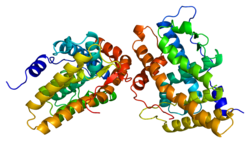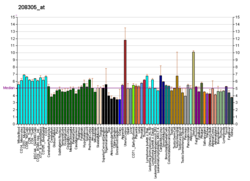Progesterone receptor: Difference between revisions
m added "Transcription factors" category |
PBB Automatic Update: Updated Protein Box, Skipped Summary, and Updated Citations. |
||
| Line 75: | Line 75: | ||
*{{cite journal | author=Leonhardt SA, Boonyaratanakornkit V, Edwards DP |title=Progesterone receptor transcription and non-transcription signaling mechanisms. |journal=Steroids |volume=68 |issue= 10-13 |pages= 761-70 |year= 2004 |pmid= 14667966 |doi= }} |
*{{cite journal | author=Leonhardt SA, Boonyaratanakornkit V, Edwards DP |title=Progesterone receptor transcription and non-transcription signaling mechanisms. |journal=Steroids |volume=68 |issue= 10-13 |pages= 761-70 |year= 2004 |pmid= 14667966 |doi= }} |
||
*{{cite journal | author=Conneely OM, Mulac-Jericevic B, Lydon JP |title=Progesterone-dependent regulation of female reproductive activity by two distinct progesterone receptor isoforms. |journal=Steroids |volume=68 |issue= 10-13 |pages= 771-8 |year= 2004 |pmid= 14667967 |doi= }} |
*{{cite journal | author=Conneely OM, Mulac-Jericevic B, Lydon JP |title=Progesterone-dependent regulation of female reproductive activity by two distinct progesterone receptor isoforms. |journal=Steroids |volume=68 |issue= 10-13 |pages= 771-8 |year= 2004 |pmid= 14667967 |doi= }} |
||
*{{cite journal | author=Bagchi MK, Tsai SY, Tsai MJ, O'Malley BW |title=Ligand and DNA-dependent phosphorylation of human progesterone receptor in vitro. |journal=Proc. Natl. Acad. Sci. U.S.A. |volume=89 |issue= 7 |pages= 2664-8 |year= 1992 |pmid= 1557371 |doi= }} |
|||
*{{cite journal | author=Kastner P, Krust A, Turcotte B, ''et al.'' |title=Two distinct estrogen-regulated promoters generate transcripts encoding the two functionally different human progesterone receptor forms A and B. |journal=EMBO J. |volume=9 |issue= 5 |pages= 1603-14 |year= 1990 |pmid= 2328727 |doi= }} |
|||
*{{cite journal | author=Guiochon-Mantel A, Loosfelt H, Lescop P, ''et al.'' |title=Mechanisms of nuclear localization of the progesterone receptor: evidence for interaction between monomers. |journal=Cell |volume=57 |issue= 7 |pages= 1147-54 |year= 1989 |pmid= 2736623 |doi= }} |
|||
*{{cite journal | author=Misrahi M, Atger M, d'Auriol L, ''et al.'' |title=Complete amino acid sequence of the human progesterone receptor deduced from cloned cDNA. |journal=Biochem. Biophys. Res. Commun. |volume=143 |issue= 2 |pages= 740-8 |year= 1987 |pmid= 3551956 |doi= }} |
|||
*{{cite journal | author=Fernandez MD, Carter GD, Palmer TN |title=The interaction of canrenone with oestrogen and progesterone receptors in human uterine cytosol. |journal=British journal of clinical pharmacology |volume=15 |issue= 1 |pages= 95-101 |year= 1983 |pmid= 6849751 |doi= }} |
|||
*{{cite journal | author=Oñate SA, Tsai SY, Tsai MJ, O'Malley BW |title=Sequence and characterization of a coactivator for the steroid hormone receptor superfamily. |journal=Science |volume=270 |issue= 5240 |pages= 1354-7 |year= 1995 |pmid= 7481822 |doi= }} |
|||
*{{cite journal | author=Zhang Y, Beck CA, Poletti A, ''et al.'' |title=Identification of phosphorylation sites unique to the B form of human progesterone receptor. In vitro phosphorylation by casein kinase II. |journal=J. Biol. Chem. |volume=269 |issue= 49 |pages= 31034-40 |year= 1995 |pmid= 7983041 |doi= }} |
|||
*{{cite journal | author=Mansour I, Reznikoff-Etievant MF, Netter A |title=No evidence for the expression of the progesterone receptor on peripheral blood lymphocytes during pregnancy. |journal=Hum. Reprod. |volume=9 |issue= 8 |pages= 1546-9 |year= 1995 |pmid= 7989520 |doi= }} |
|||
*{{cite journal | author=Kalkhoven E, Wissink S, van der Saag PT, van der Burg B |title=Negative interaction between the RelA(p65) subunit of NF-kappaB and the progesterone receptor. |journal=J. Biol. Chem. |volume=271 |issue= 11 |pages= 6217-24 |year= 1996 |pmid= 8626413 |doi= }} |
|||
*{{cite journal | author=Wang JD, Zhu JB, Fu Y, ''et al.'' |title=Progesterone receptor immunoreactivity at the maternofetal interface of first trimester pregnancy: a study of the trophoblast population. |journal=Hum. Reprod. |volume=11 |issue= 2 |pages= 413-9 |year= 1996 |pmid= 8671234 |doi= }} |
|||
*{{cite journal | author=Thénot S, Henriquet C, Rochefort H, Cavaillès V |title=Differential interaction of nuclear receptors with the putative human transcriptional coactivator hTIF1. |journal=J. Biol. Chem. |volume=272 |issue= 18 |pages= 12062-8 |year= 1997 |pmid= 9115274 |doi= }} |
|||
*{{cite journal | author=Jenster G, Spencer TE, Burcin MM, ''et al.'' |title=Steroid receptor induction of gene transcription: a two-step model. |journal=Proc. Natl. Acad. Sci. U.S.A. |volume=94 |issue= 15 |pages= 7879-84 |year= 1997 |pmid= 9223281 |doi= }} |
|||
*{{cite journal | author=Shanker YG, Sharma SC, Rao AJ |title=Expression of progesterone receptor mRNA in the first trimester human placenta. |journal=Biochem. Mol. Biol. Int. |volume=42 |issue= 6 |pages= 1235-40 |year= 1997 |pmid= 9305541 |doi= }} |
|||
*{{cite journal | author=Richer JK, Lange CA, Wierman AM, ''et al.'' |title=Progesterone receptor variants found in breast cells repress transcription by wild-type receptors. |journal=Breast Cancer Res. Treat. |volume=48 |issue= 3 |pages= 231-41 |year= 1998 |pmid= 9598870 |doi= }} |
|||
*{{cite journal | author=Williams SP, Sigler PB |title=Atomic structure of progesterone complexed with its receptor. |journal=Nature |volume=393 |issue= 6683 |pages= 392-6 |year= 1998 |pmid= 9620806 |doi= 10.1038/30775 }} |
|||
*{{cite journal | author=Boonyaratanakornkit V, Melvin V, Prendergast P, ''et al.'' |title=High-mobility group chromatin proteins 1 and 2 functionally interact with steroid hormone receptors to enhance their DNA binding in vitro and transcriptional activity in mammalian cells. |journal=Mol. Cell. Biol. |volume=18 |issue= 8 |pages= 4471-87 |year= 1998 |pmid= 9671457 |doi= }} |
|||
*{{cite journal | author=Nawaz Z, Lonard DM, Smith CL, ''et al.'' |title=The Angelman syndrome-associated protein, E6-AP, is a coactivator for the nuclear hormone receptor superfamily. |journal=Mol. Cell. Biol. |volume=19 |issue= 2 |pages= 1182-9 |year= 1999 |pmid= 9891052 |doi= }} |
|||
}} |
}} |
||
{{refend}} |
{{refend}} |
||
Revision as of 03:54, 19 November 2007
The progesterone receptor is an intracellular steroid receptor that specifically binds progesterone. Expressed by a single gene (chromosome 11q22), it has two main forms, A and B, that differ in their molecular weight.[5][6][7]
Structure
Like all steroid receptors, the progesterone receptor has an amino and a carboxyl terminal, and between them the regulatory domain, a DNA binding domain, the hinge section, and the hormone binding domain. A special transcription activation function (TAF), called TAF-3, is present in the progesterone receptor-B, in a B-upstream segment (BUS) at the amino acid terminal. This segment is not present in the receptor-A.
Isoforms
As demonstrated in progesterone receptor-deficient mice, the physiological effects of progesterone depend completely on the presence of the human progesterone receptor (hPR), a member of the steroid-receptor superfamily of nuclear receptors. The single-copy human (hPR) gene uses separate promoters and translational start sites to produce two isoforms, hPR-A and -B, which are identical except for an additional 165 amino acids present only in the N terminus of hPR-B.[8] Although hPR-B shares many important structural domains as hPR-A, they are in fact two functionally distinct transcription factors, mediating their own response genes and physiological effects with little overlap. Selective ablation of PR-A in a mouse model, resulting in exclusive production of PR-B, unexpectedly revealed that PR-B contributes to, rather than inhibits, epithelial cell proliferation both in response to estrogen alone and in the presence of progesterone and estrogen. These results suggest that in the uterus, the PR-A isoform is necessary to oppose estrogen-induced proliferation as well as PR-B-dependent proliferation.
Functional Polymorphisms
The Immaculata De Vivo laboratory at the Harvard Medical School has identified six variable sites, including four polymorphisms in the hPR gene and five common haplotypes. One promoter region polymorphism, +331G/A, creates a unique transcription start site. Biochemical assays showed that the +331G/A polymorphism increases transcription of the PR gene, favoring production of hPR-B in an Ishikawa endometrial cancer cell line.
Several studies have now shown no association between progesterone receptor gene +331G/A polymorphisms and breast or endometrial cancers.[9][10] However, these follow-up studies lacked the sample size and statistical power to make any definitive conclusions, due to the rarity of the +331A SNP. It is currently unknown which if any polymorphisms in this receptor is of significance to cancer.
Function
Estrogen is necessary to induce the progesterone receptors. When no binding hormone is present the carboxyl terminal inhibits transcription. Binding to a hormone induces a structural change that removes the inhibitory action. Progesterone antagonists prevent the structural reconfiguration.
After progesterone binds to the receptor, restructuring with dimerization follows and the complex enters the nucleus and binds to DNA. There transcription takes place, resulting in formation of messenger RNA that activates cytoplasmatic ribosomes to produce specific proteins.
See also
Further reading
References
- ^ a b c GRCh38: Ensembl release 89: ENSG00000082175 – Ensembl, May 2017
- ^ a b c GRCm38: Ensembl release 89: ENSMUSG00000031870 – Ensembl, May 2017
- ^ "Human PubMed Reference:". National Center for Biotechnology Information, U.S. National Library of Medicine.
- ^ "Mouse PubMed Reference:". National Center for Biotechnology Information, U.S. National Library of Medicine.
- ^ Gadkar-Sable S, Shah C, Rosario G, Sachdeva G, Puri C (2005). "Progesterone receptors: various forms and functions in reproductive tissues". Front. Biosci. 10: 2118–30. doi:10.2741/1685. PMID 15970482.
{{cite journal}}: CS1 maint: multiple names: authors list (link) - ^ Kase, Nathan G.; Speroff, Leon; Glass, Robert L. (1999). Clinical gynecologic endocrinology and infertility. Hagerstwon, MD: Lippincott Williams & Wilkins. ISBN 0-683-30379-1.
{{cite book}}: CS1 maint: multiple names: authors list (link) - ^ Fritz, Marc A.; Speroff, Leon (2005). Clinical gynecologic endocrinology and infertility. Hagerstwon, MD: Lippincott Williams & Wilkins. ISBN 0-7817-4795-3.
{{cite book}}: CS1 maint: multiple names: authors list (link) - ^ Kastner P, Krust A, Turcotte B, Stropp U, Tora L, Gronemeyer H, Chambon P (1990). "Two distinct estrogen-regulated promoters generate transcripts encoding the two functionally different human progesterone receptor forms A and B". EMBO J. 9 (5): 1603–14. PMID 2328727.
{{cite journal}}: CS1 maint: multiple names: authors list (link) - ^ Feigelson HS, Rodriguez C, Jacobs EJ, Diver WR, Thun MJ, Calle EE (2004). "No association between the progesterone receptor gene +331G/A polymorphism and breast cancer". Cancer Epidemiol. Biomarkers Prev. 13 (6): 1084–5. PMID 15184270.
{{cite journal}}: CS1 maint: multiple names: authors list (link) - ^ Dossus L, Canzian F, Kaaks R, Boumertit A, Weiderpass E (2006). "No association between progesterone receptor gene +331G/A polymorphism and endometrial cancer". Cancer Epidemiol. Biomarkers Prev. 15 (7): 1415–6. doi:10.1158/1055-9965.EPI-06-0215. PMID 16835347.
{{cite journal}}: CS1 maint: multiple names: authors list (link)
External links
- Progesterone+Receptors at the U.S. National Library of Medicine Medical Subject Headings (MeSH)






